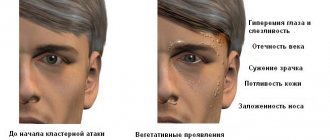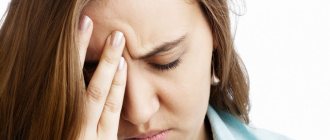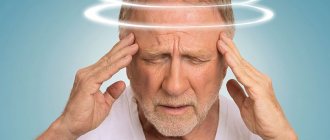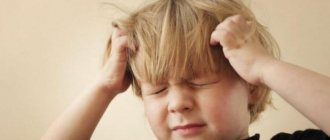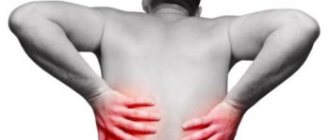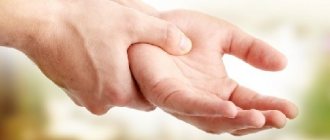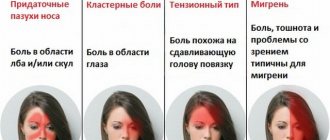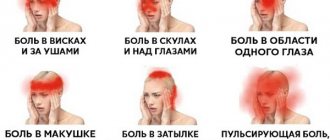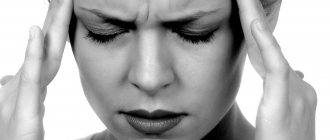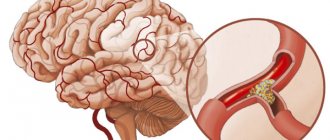At almost any age, a person experiences changes in blood pressure.
And in real-time conditions this is a fairly common occurrence.
Deviation of blood pressure readings from the norm is always accompanied by unpleasant sensations.
Topic: Grandma's blood pressure has returned to normal!
From: Christina ( [email protected] )
To: Administration otgipertonii.ru
Christina, Moscow
My grandmother’s hypertension is hereditary - most likely, I will have the same problems as I grow older.
I accidentally found an article on the Internet that literally saved my grandmother. She was tormented by headaches and had a repeated crisis. I bought the course and monitored the correct treatment.
After 6 weeks she even started talking differently. She said that her head no longer hurts, but she still takes pills for blood pressure. I am sending a link to the article
How often do migraine headaches occur in a person’s life?
The frequency of attacks varies, usually occurring 1 to 4 times a month. Some people experience very severe migraine headaches several times a week. Attacks usually begin in the morning, when a person wakes up from pain, sometimes the head hurts even at night. The nature of migraines is just as unpredictable. Over the years, the frequency and nature of attacks changes. For some people, their number decreases with age, while for others, very severe headaches of this type may even disappear forever, or at least temporarily.
During pregnancy, the number of attacks often decreases or disappears altogether. Conversely, there are cases when this very severe headache (when it hurts in the temporal and frontal region, or in the back of the head, which is accompanied by nausea) appeared for the first time during pregnancy. The course of the disease can change over the years and under the influence of treatment that can suppress headaches and accompanying symptoms (nausea, vomiting, photophobia...).
Features of treatment
Elimination of such unpleasant manifestations is carried out using various methods. These include:
- impact on the underlying disease;
- drug therapy to relieve pain;
- surgical intervention.
Since unpleasant symptoms are only a consequence of some disorder in the body, it is first necessary to act on the cause of the ailment. Treatment of the underlying disease is carried out in accordance with the patient’s well-being; Often the symptoms disappear during therapy and do not require additional treatment.
As part of drug treatment aimed directly at eliminating nausea and headaches in the temples, the following medications are used:
- Analgesics, antispasmodics and non-steroids. The drugs help get rid of pain and reduce the frequency of attacks, but are not able to influence the cause of the development of unpleasant symptoms.
- Antidepressants. They are used in cases where malaise arises from neurosis and fatigue or against the background of migraine.
- Beta blockers. The action of drugs is aimed at improving heart function and preventing arrhythmia.
- Glucocorticosteroids . Medicines in this group allow you to remove toxins from the body and reduce the intensity of the inflammatory process. Such drugs are used in situations where nausea and headache are caused by intoxication or inflammation.
- Medicines for vascular tone. Since cephalgia is often associated with disturbances in the functioning of the circulatory system, in these cases it is advisable to use drugs whose action is aimed at strengthening the walls of blood vessels and increasing their patency.
- Diuretics . Medicines are effective for increased intracranial pressure, edema and vascular problems.
- Sedative medications. Indispensable in situations where symptoms arise under the influence of psychological factors.
Surgical treatment is used in cases where tumors are found in the brain or drug therapy has not brought a positive result.
What can cause migraine headaches?
Most people who suffer from migraines have certain factors that trigger the attack. Knowing these triggers is very important because if you can avoid them, you can reduce the frequency of your attacks. The most common factor causing headaches in the forehead and temples and nausea is stress and various unpleasant emotional experiences. However, positive emotions (for example, a long trip or a friendly meeting) can cause very severe pain in the temporal region. What to do? In both cases, a period of rest and relaxation after severe mental or emotional stress helps.
About 45-50% of patients indicate weather changes as a provoking factor. It has not yet been determined which climatic conditions have a significant impact on the onset of migraine. We are probably talking about changes in humidity and changes in the amount of positive ions in the atmosphere.
Another important point is sleep disturbances. Not only lack of sleep is harmful, but also excessively long sleep. This explains the occurrence of Sunday attacks in some patients who like to pamper themselves on the night from Saturday to Sunday with too much sleep. As a result, a headache occurs (pain in the forehead, temples, back of the head..., nausea, sometimes vomiting). What to do? Don't extend your bedtime on weekends, try to get out of bed at the same time.
For many women, migraine attacks are associated with the menstrual cycle. Headache (directly, in the temples or in the temporal region, in the forehead and back of the head...), usually before or during menstruation. Some sources call this type of illness “menstrual migraine.” Other women may experience attacks in the middle of their menstrual cycle, when ovulation occurs. What to do? In this case, magnesium and painkillers (Paracetamol, Ibuprofen) can help.
Approximately a quarter of the gamers indicate that there is a headache (directly, in the temples or in the temporal region, in the area of the forehead and back of the head..., there is nausea) after eating certain foods. There are many of these products, the most common of which include cheeses (especially Parmesan, Camembert, etc.), chocolate, milk and dairy products (yogurt), nuts, canned and marinated meats, salami and sausages. Fatty foods, citrus fruits, tomatoes, etc. are also suspected. In addition, caffeine-containing drinks, such as coffee or Coca-Cola, as well as all alcoholic beverages, the most common culprits of migraines are red wine and port. What to do? It is necessary to limit the consumption of foods that may be triggers of the disease.
Another factor why headaches occur in the area of the forehead in the temples or in the temporal region, in the area of the forehead and back of the head, is irregular eating and prolonged fasting. Migraine sufferers should eat regularly and not skip breakfast and snacks. Equally, the condition of pain in the temples is also affected by insufficient fluid intake and dehydration. Pungent, unpleasant odors, harsh, strong light and prolonged noise (entertainment, discos, etc.), excessive exposure to the sun... All these factors can cause an attack. What to do? Try to avoid these provoking factors or at least limit their effect on the body.
Health care
Frequent dizziness with high blood pressure requires the help of a qualified doctor. Before starting treatment, the doctor examines the patient, studies symptoms, collects anamnesis, and measures blood pressure. With the help of examinations, the doctor finds out why there is high blood pressure, headaches and nausea. The clinical picture under consideration may be associated with congenital narrowing of the aorta, renal and endocrine diseases, and pathology of the adrenal glands. Similar symptoms occur with tumors of the brain. Drugs from certain pharmacological groups can increase blood pressure. To relieve headaches, they take adrenergic blockers, diuretics, and ACE inhibitors. The therapist decides which drug will relieve the symptoms for each patient individually.
In the fight against occipital pain syndrome, which is accompanied by nausea with high blood pressure, it is recommended to place a Nitroglycerin or Validol tablet under the tongue. The described clinical picture manifests itself during a hypertensive crisis, so you need to act correctly and quickly. Then you need to call an ambulance.
If you have a headache with high blood pressure, it is recommended to restore your breathing. To do this, the patient must take a deep breath, and while holding his breath, exhale slowly. The exercise is performed in a lying position. It is repeated several times. If there are mustard plasters, they are applied to the calves. You can make a foot bath. The feet are kept in hot water for 15 minutes. A similar manipulation is carried out regarding the hands.
Migraine prevention
Appropriate nutrition and limiting exposure to factors that cause attacks. These preventive measures include:
1. Adequate physical and mental stress, alternating with active rest.
2. Regular adequate sleep.
3. Diet excluding the foods described above that can cause an attack.
4. Avoiding fasting, as well as overeating. Limit consumption of caffeinated drinks, alcohol and smoking.
5. Regular walks, suitable sports and outdoor exercise.
6. Avoiding prolonged inactivity; interesting and attractive work has a positive effect on the course of migraines.
7. Prevent head and neck injuries.
Diagnostics
An initial examination by a general practitioner will determine the type of disease (hypertension-hypotension). The patient will be interviewed, and the functioning of the endocrine and nervous systems will be checked.
The following tests are usually prescribed:
- extended blood test;
- hormone tests;
- Ultrasound of the kidneys;
- checking the blood vessels of the legs;
- electrocardiography;
- echocardiography;
- electroencephalography.
Based on the results obtained, the therapist may refer you to another doctor with a narrower specialty: cardiologist, nephrologist, endocrinologist, neurologist.
Non-pharmacological methods of prevention
Non-pharmacological methods are suitable for patients who, for various reasons, cannot or do not want to take medications, but they are also a good complement to drug treatment. These include:
1. Acupuncture, acupuncture.
2. Relaxation methods, autogenic training.
3. Training in self-control and overcoming stress.
4. Climatic and sanatorium-resort treatment.
5. Physical therapy (baths, massage).
Therapy
Before seeking the advice of a doctor or the arrival of an ambulance, you can partially relieve the pain with the help of medications.
With low blood pressure, the headache goes away after taking caffeine-containing drugs (Askofen, Citramon, Pentalgin), herbal medicines and anticholinergics (Bellataminal).
They also recommend:
- take a horizontal position and place a pillow under your feet;
- strong sweet tea or coffee with sugar.
- ensure the supply of fresh air;
- cold and hot shower;
- massage of the head and collar area.
With elevated blood pressure, headaches can be relieved with thiazide diuretics (Diuril, Naklex) or other diuretics (Veroshpiron, Diursan).
In addition to the above drugs, it is recommended:
- applying mustard plasters to the back of the head;
- circular massage of the occipital region;
- foot baths (with water temperature no higher than 45 C);
- rubbing the eyes.
It is not recommended to try to cure hypertension on your own, since traditional methods are only an addition to the course of therapy prescribed by a doctor.
Your blood pressure has returned to normal, but your head still hurts?
You can get rid of pain with the help of medications, such as “Ascopar”, “Combispasm”, “Solpadeine” and others.
There are also simple methods:
- cold water compress on the forehead and occipital area;
- in case of severe pain, take a hot foot bath;
- ventilate the room;
- lie down in complete darkness and silence;
- You can add 3-5 drops of lavender oil to your bath.
The occurrence of cephalgia (headache) can be caused by external and physiological reasons
External causes are: stress, changes in atmospheric pressure, poor nutrition.
Physiological causes should be taken seriously and promptly examined, as such causes may include infectious and severe viral diseases, such as meningitis.
Remember that almost all diseases associated with high blood pressure can lead to serious consequences! Therefore, it is necessary to consult a doctor in a timely manner.
Why do you get headaches and nausea when your blood pressure is low?
If blood pressure drops below 90/60 mm Hg. Art., the following symptoms are noted:
- headache, advantage only on one side
- be sick;
- forehead becomes covered with cold sweat;
- pawns ears;
- floaters appear in the eyes;
- breathing becomes difficult;
- pulse quickens.
Their main cause is orthostatic hypotension. This is the name of the phenomenon in which, during a change in body position, the blood supply to the brain is disrupted.
Even with low blood pressure, nausea occurs due to:
- kidney problems;
- low hemoglobin;
- exhaustion of the body.
